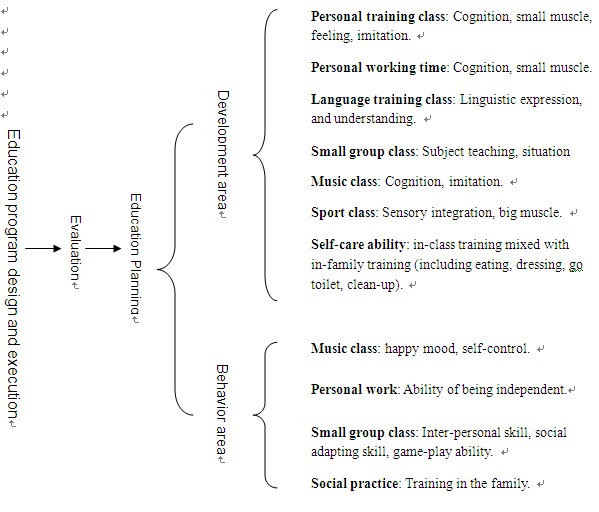We believe, although infantile autism is nowadays a worldwide difficult problem, if we can have full understanding of it and design a proper plan of future development according to a child’s situation and capacity in his/her early stage, provide him/her with help and support in a manner of “understand, respect, accept and love” everyday, so to build a bridge of understanding and adaptation between the child and the world, the child will certainly get over the various disorders, make great progress and live a happy and respectful life in his/her adult age. Since the infantile autism is a kind of spectrum disorder and every single child has his/her own complications, the extent of recovery depends a lot on his/her own characters, family atmosphere, proper training theory and methods. Different children’s extent of recovery may be divided into six levels as follows:
1. Self-reliance Social Life: They still have some characteristics of autism in the thought, behavior, emotion and daily communication. However, this will not constitute the barrier of integrating into the society. They can normally, independently participate in the social life, and have the capacity of playing the social role. They will have the normal marriage and family, independent life attitude, comprehensive independent personality and capacity.
2. Half Self-reliance Social Life: They will keep some characteristics of autism in the adult age, have the fundamental capacity of intercourse and can integrate into the society at a certain level with assistance and tolerance. They can participate in the social life and play the social role in some extent, and have the possibility to involve in the physical and mental life with an opposite sex. They will have the independent personality but still suffer a lack in autonomy.
3. Self-care Social Life: They will keep more characteristics of autism. They can handle instrumental interaction, but are not good enough to be involved in social life. Some of them can complete the “job” arranged by the others, however, they do not understand what the social meaning of the “job” is. They can independently stay at home, deal with daily matters in the house and go out alone to handle some matters relating to the daily matters within a certain range. They have certain independent personality, but still need more persuasive and guiding help. They can independently have some meaningful entertainment and leisure.
4. Half Self-care Social Life: They have more significant characteristics of autism. The can handle simple instrumental interaction, but it is impossible for them to involve in social life. They can fundamentally stay in home safely with direct or indirect help from the family, but cannot go out alone. Their main communicatees will be their family members or people they are familiar with. They will have difficulty in communicating with strangers and will have their own special life process and entertainment. They will have the independent personality in some extent, but still need a mandatory management from outside.
5. Cared by Family, Others and Society: They have more significant characteristics of autism, have difficulty to handle simple instrumental interaction, and are impossible to involve in social life. Normally, their behaviors and emotions can be controlled. They need to be taken care of by the family or others, can have a safe life under supervision, but still cannot stay alone in house. They have no independent personality, and need comprehensive guiding and mandatory management from outside.
6. Fully Cared by Family or Relatives: They have severe characteristics of autism, especially being aggressive, destructive or have serious emotion problems. They are unable to carry out daily communication, will be rejected by others and organizations, and need to be solely taken care of by the family. They have no independent personality and depend on the mandatory management from outside. They are unable to stay at home alone and need to be accompanied by (multiple) others.
As described in abovementioned targets, the extent of self-reliance a child can reach in the future is not only related to his intellectual quotient, but also and more closely, related to his capacity of self-care, social communication and self-control of emotion. To help more children to reach a higher target on the basis of his original state, Qingcongquan has established a clear object at the beginning of the training, i.e., to help the parents to get a clear recognize of the children’s development direction, to lead the children to learn for self-care before self-reliance. To make the wish come true, we have designed a process of the education.
(Attached is the education process designed by Doctor Lu)

We must admit, compare to the developed nations and districts, the living environment and quality of people who are suffering autism in China still fall far behind. There are reports about autism suffers who has once been locked in a cage or by an iron chain in all parts of the country. It is mainly because of the lack in help and understanding of autism in the early stage of convalescence. Therefore, the parents and teachers shall understand the infantile autism correctly, find the correct development discretion for them, and support them instead of trying to change them. As a professional institute, we hope we can work with the families in close cooperation, treasure the key period of the children’s recovery, make the best effort to help the children to enhance all kinds of capacities, and bring a better life to more children and a happier family to you.